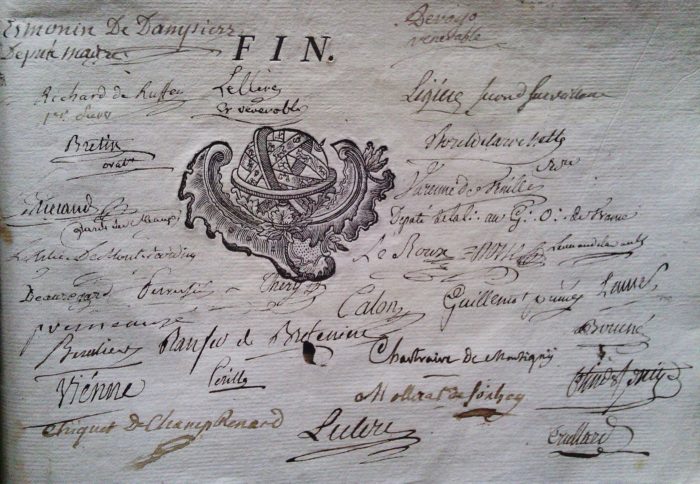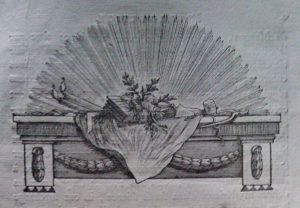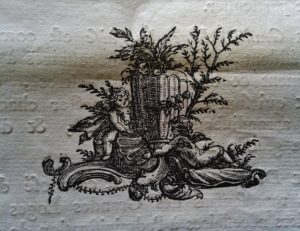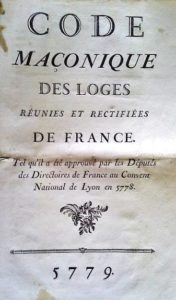 Code maçonique des Loges réunies et rectifiées de France Tel qu’il a été approuvé par les Députés des Directoires de France au Couvent National de Lyon en 5778. No place, no name, 5779 [i.e. 1779]. In-4° (34 x 22,5 cm) . 43 pp. Type ornament on title page, beautiful Masonic borders and endpieces. Sewed, with a waiting cover made up of 2 sheets of contemporary watercolours paper, attached to the text by 2 sewings.
Code maçonique des Loges réunies et rectifiées de France Tel qu’il a été approuvé par les Députés des Directoires de France au Couvent National de Lyon en 5778. No place, no name, 5779 [i.e. 1779]. In-4° (34 x 22,5 cm) . 43 pp. Type ornament on title page, beautiful Masonic borders and endpieces. Sewed, with a waiting cover made up of 2 sheets of contemporary watercolours paper, attached to the text by 2 sewings.
Original edition, rare. Copy of the Lodge “La Concorde Dijon’s East, signed by the Venerable Master, the dignitaries of the Lodge, the college of Officers and the members of tle Lodge., around 1780.
The new Code of Regulations for Symbolic Freemasonry, discussed and approved 6 at 8 December 1778, at the National Convent of Gauls held from 25 November to 10 December 1778 in Lyon, was printed in 1779 under the title of Code maçonique des Loges réunies et rectifiées de France. Consisting of an introduction followed by 16 chapters, it’s one of the founding texts, still in force, of Scottish Rite Rectified. It introduces the official recognition of the rank of Scottish Master (ch. X : Des Grades Maçonniques).
The Lodge La Concorde Dijon’s East was formed 1771 and stopped its work on 22 July 1789. “Perhaps the most important fact in the history of “La Concorde” is the role it played in the expansion of the Scottish Rite between 1780 and 1785 ” (Daniel Ligou, La maçonnerie dijonnaise à la fin du XVIIIe siècle, p. 42). This rite was introduced in this Lodge in 1780 by Antoine Esmonin de Dampierre (1744-1824), adviser of Parliament; he was Chevalier Bienfaisant de la Cité Sainte. He was also a member of La Candeur in Paris, then La Bienfaisance, Lodge managed by Jean-Baptiste Willermoz in Lyon. Exiled in Switzerland during the Revolution, he abandoned Freemasonry to enter the quietist movement of Pierre Dutoit-Membrini in a vision from Mrs. Guyon.. He is the author of Réflexions impartiales sur le magnétisme animal, Geneva and Paris, 1784, and with Vérités divines pour le cœur et l’esprit, par le M. de D…., Daniel Pétillet, Lausanne, 1823, opus all imbued with Martinesist theosophy
La Concorde was under the Vth R.E.R. Province. and its “Directory of Burgundy”, in Strasbourg. In 1785, many members of La Concorde, which had been “rectified” with the agreement of the Greater East, conflicted with the R.E.R.. It seems that Christian orthodoxy, which the Venerable of the Lodge up to 1789, Charles-Claude Devoyo de Champrenault, was one of the strongest representatives, worried about the illuminist tendencies of Esmonin de Dampierre and his followers (See R. Bultot, Annales historiques de la Révolution française, year 1998, vol. 314, pp. 719-722).
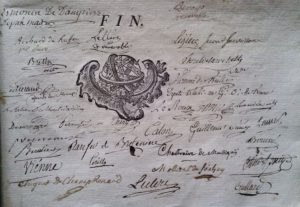 Any Brother received in a rectified Lodge is required to sign this Code (cf. p. 9), so, are at the end of the book the signatures, among others,, . Louis Esmonin de Dampierre, former President in Parliament, Député-Maître, . Charles-Claude Devoyo [de Champrenault], councillor to the Dijon Parliament, Vénérable, . Lellève ( ?), ex-Vénérable, . Richard de Ruffer, 1st Surv[eillant], . Ligier, Adviser-Master in the Chamber of Auditors, Second Surveillant, . Jean-Baptiste-Hugues Bretin, lawyer in Parliament, Doctor of the University, Orateur, . Charles-Henri Borel de la Rochette, lawyer and archivist of the city of Dijon, Secrétaire, . Castrerand (?) (Garde des Sceaux), . Claude-Philibert Varenne de Penilles, squire in Paris, Député de la L[odge] au G[rand] O[rient] of France, as well as Brothers De Montjardin (?), Jean-Baptiste de Beauregard, officer in the Guienne regiment, Chrétien-Gaspard de Macheco, marquis de Premeaux, president, Noël Besulier, Mastery surveyor, Comte de Vienna (Isère), former cavalry camp man of a regiment of his name, Chiquet de ChampRenard, Councillor to Parliament, François Leclerc, organist of the church of Dijon, Jean-Baptiste Pelversié, lawyer in Parliament, Pierre Thery, Director at the Ice Depot, Pierre Bernard Ranfer de Bretenière, Adviser-Master in the Chamber of Auditors, André Nicolas Perille, surveyor, Antoine-Michel Le Roux, Chief Surgeon of the Hospital, Antoine-Bernard Dorse, Auditor, François-Philibert Laureau de Laveault, Accounts Master, Guillaume-Augustin Calon, Councillor to Parliament, Jean Guillemot, lawyer in Parliament, Guillaume-Bernard Pernet [de Charay], Knight of St.. Louis, Dijon Castle Major, Claude-Marie-Antoine Chartraire de Montigny, Treasurer General of the States of Burgundy, Jean-Jacques-Antoine Mollerat de Souhey, lord of Souhey, Antoine Bouché, Councillor to the King, Notary, Jacob Cotin de Joncy, Councillor to Parliament, Etienne Guelaud, Solicitor to Consuls.
Any Brother received in a rectified Lodge is required to sign this Code (cf. p. 9), so, are at the end of the book the signatures, among others,, . Louis Esmonin de Dampierre, former President in Parliament, Député-Maître, . Charles-Claude Devoyo [de Champrenault], councillor to the Dijon Parliament, Vénérable, . Lellève ( ?), ex-Vénérable, . Richard de Ruffer, 1st Surv[eillant], . Ligier, Adviser-Master in the Chamber of Auditors, Second Surveillant, . Jean-Baptiste-Hugues Bretin, lawyer in Parliament, Doctor of the University, Orateur, . Charles-Henri Borel de la Rochette, lawyer and archivist of the city of Dijon, Secrétaire, . Castrerand (?) (Garde des Sceaux), . Claude-Philibert Varenne de Penilles, squire in Paris, Député de la L[odge] au G[rand] O[rient] of France, as well as Brothers De Montjardin (?), Jean-Baptiste de Beauregard, officer in the Guienne regiment, Chrétien-Gaspard de Macheco, marquis de Premeaux, president, Noël Besulier, Mastery surveyor, Comte de Vienna (Isère), former cavalry camp man of a regiment of his name, Chiquet de ChampRenard, Councillor to Parliament, François Leclerc, organist of the church of Dijon, Jean-Baptiste Pelversié, lawyer in Parliament, Pierre Thery, Director at the Ice Depot, Pierre Bernard Ranfer de Bretenière, Adviser-Master in the Chamber of Auditors, André Nicolas Perille, surveyor, Antoine-Michel Le Roux, Chief Surgeon of the Hospital, Antoine-Bernard Dorse, Auditor, François-Philibert Laureau de Laveault, Accounts Master, Guillaume-Augustin Calon, Councillor to Parliament, Jean Guillemot, lawyer in Parliament, Guillaume-Bernard Pernet [de Charay], Knight of St.. Louis, Dijon Castle Major, Claude-Marie-Antoine Chartraire de Montigny, Treasurer General of the States of Burgundy, Jean-Jacques-Antoine Mollerat de Souhey, lord of Souhey, Antoine Bouché, Councillor to the King, Notary, Jacob Cotin de Joncy, Councillor to Parliament, Etienne Guelaud, Solicitor to Consuls.
Paul Fesch : Bibliographie de la Franc-Maçonnerie et des sociétés secrètes, Brussels, Deny, 1976, col. 330 (in-folio et s.d.). Just 3 printed copies listed by the CCFR: one copy at the BNF, one at the Lyon Library (with handwritten notes from Willermoz), and one to Selestat Library; the copy of the BNF, scanned, is posterior (ortography, typography, border, endpieces, pagination), although dated 1779.
Mark of a central fold, sheet serving as 1st cover is dirty with small tears at the fold and some lack, attached to the text by only one sewing. , a few spots on the title page, marginal brown clear cercle fading on the 4 first quires, some small and rare ink stains. onside very well.
Rare copy, by autograph signatures, in good condition despite the reported defects.
Sold
